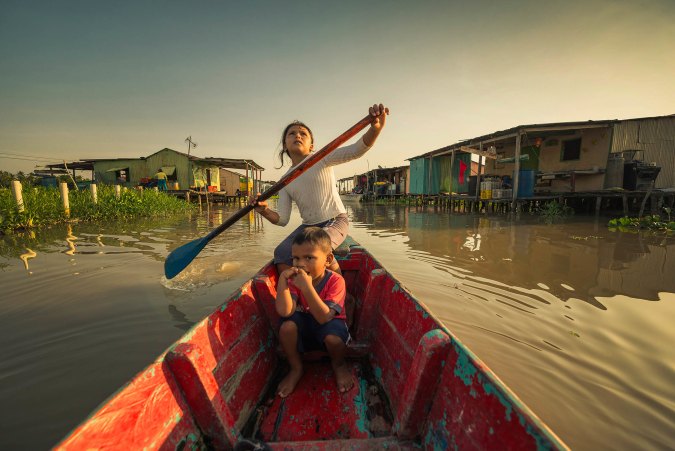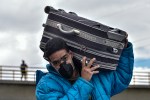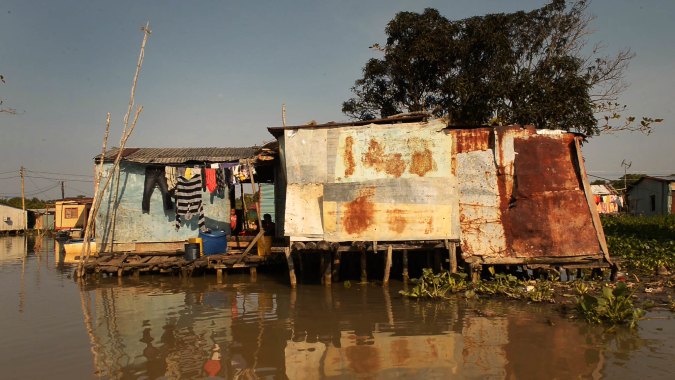“Once upon a time …” is usually a setup for a fairy tale, but in Anabel Rodríguez Ríos’s contemplative documentary Once Upon a Time in Venezuela, it’s a fairy tale setting that’s facing a harsh reality. Like the rest of the country, the town of Congo Mirador has been beset with shortages and shrinking resources. Now, its residents are facing a new foe: a strange sediment and pollution is making its way to their corner of Lake Maracaibo, causing the town to rot from the inside out. Where once lived 700 people, Congo Mirador has dwindled to less than 30 families year-round near the documentary’s end. A few final scenes suggest the floating community is no more.
Once Upon a Time in Venezuela doubles as a close-up look into what the country is facing at large. Its people are struggling. Some try to find comfort in a government that lacks the resources to help its marginalized. Others, driven to the brink of starvation, must leave their home to survive. This political and economic battle is vividly illustrated by two women in the village, Mrs. Tamara and Natalie. A devout Hugo Chávez follower, Mrs. Tamara has all the makings of a fanatic, standing behind the communist government’s story and supporting the party’s cause to whatever means necessary — bribery and coercion included. She defends Chavez’s appointed successor against all odds. In contrast, Natalie stands against Mrs. Tamara’s tactics and her politics. She refuses to accept the official party line as the only option. Although she risks losing her teaching job at the local school for falling out with Mrs. Tamara’s brutish tactics, she does so anyway, bracing for the consequences as they come.
While the personal political drama plays out, Rodríguez Ríos’s camera wanders off on its own, flowing past the floating village’s many denizens — a wizened musician, a young bride and mother-to-be, the roaming packs of children who always seem to be getting into some sort of mischief or swimming in the polluted waters that surround their homes. The camera observes both festivals and beauty pageants as well as heated government meetings and frustrating phone calls to unresponsive officials. As the sediment rises, so does the water, and the town is quite literally drowning from neglect, yet another comment on Venezuela’s current state of affairs.

Rodríguez Ríos’s lens also captures the natural beauty of this strange wonderland. It observes how gently the weeds bob in the water, how swiftly the boats cut through the ominous murky waves, the numerous birds that always seem to fly around on the outskirts of town, the orange tinge of sunset as it reflects on the water and the soundless lightning strikes as they streak across dark purple clouds. The colorful images have a way of immersing you into the setting, helping the outside viewer see what the residents of the town already know: This place is part of the ecosystem, and its disappearance will have some repercussions on their community and nature.

Like an island in a fantasy story, time seems to move slowly in Congo Mirador. When Rodríguez Ríos observes the world of Congo Mirador around her, she takes her time, moving her images at a meandering pace. Only after she returns to the site after large gaps of eight months or a year can the audience see the effects of the rapidly growing decay that threatens their environment and home. Accompanying the director and her subjects on their journey is the mournful refrains of an accordion and acoustic guitar, like a funeral dirge for what once was and will likely never be again.
“And this was the last democratic act in the recent history of Venezuela” says a bodiless voice-over on election night. Since then, all of Venezuela has never been the same as Nicolás Maduro took control of the government for himself and began a new chapter in the country’s history. While it’s tempting to give into the cynicism many in the movie harbor, it’s the film’s spirited children who keep the place alive with their games, their mischief and energy. Without them, this movie would feel very desolate indeed. Instead, they provide an antidote of much-needed levity to a grave situation, a reason for the adults to stand up for their home and hope that they will yet see another day — just not in Congo Mirador.

Once Upon a Time in Venezuela premiered at the 2020 Sundance Film Festival.




